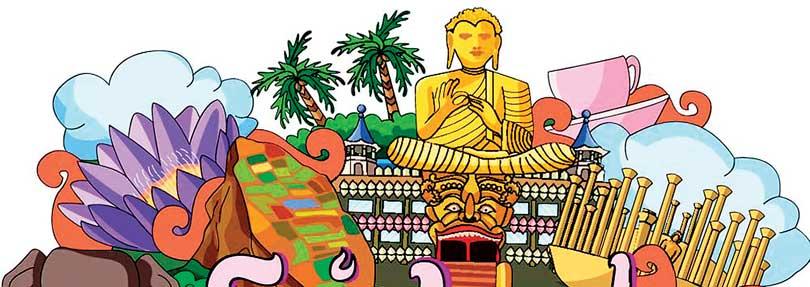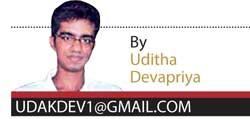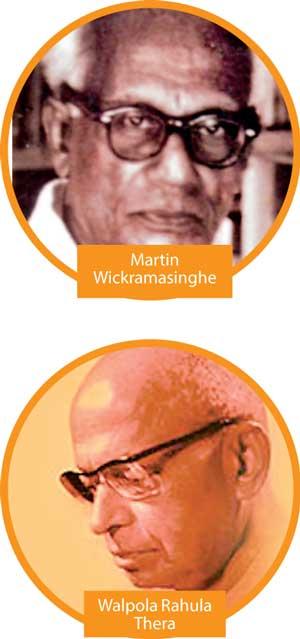Reply To:
Name - Reply Comment

 The cultural experience of the first 10 years of independent Sri Lanka was dominated by two broad trends: free education and universal franchise. In 1946, around 5% of the population were literate in English, while in 1953 the percentage had risen to 8%. Consumption patterns and increasing urbanisation empowered a non-English-speaking middle-class that clamoured for better health and educational facilities, jobs, and standards of living. But while there was a marked change in the population, this did not question the colonial economic framework. The continuation of that framework spurred a backlash in the form of a revival that culminated, in the period discussed, with the election of S.W.R.D. Bandaranaike.
The cultural experience of the first 10 years of independent Sri Lanka was dominated by two broad trends: free education and universal franchise. In 1946, around 5% of the population were literate in English, while in 1953 the percentage had risen to 8%. Consumption patterns and increasing urbanisation empowered a non-English-speaking middle-class that clamoured for better health and educational facilities, jobs, and standards of living. But while there was a marked change in the population, this did not question the colonial economic framework. The continuation of that framework spurred a backlash in the form of a revival that culminated, in the period discussed, with the election of S.W.R.D. Bandaranaike.
Here two myths must be demolished: one, that the UNP government paid no attention to a revival of the arts, and two, that the revival was aligned with the Buddha Jayanti celebrations. To refute the first of these, it is necessary to explore how the arts survived the colonial era; to refute the second, it is necessary to identify which political movements were sought after for the implementation of the recommendations of the Buddhist Commission of Inquiry.
Indeed, as this essay will show, there was no clear alignment between the one and the other: revival of the arts was often opposed to revival of Buddhism, a contradiction that the Islamic and Hindu renaissances never encountered. Before getting into that, however, it would be helpful to identify which art forms were, and were not, receptive to demands made on them reach a wider, non-English-speaking population.
In literature, as in drama and music, cultural assimilation continued unabated
Literature, dance, theatre, and music, all in all, had a larger potential for democratisation than painting, architecture, and cinema. All these (with the exception of cinema, which came later) had languished under colonial rule, since the arts, like every other aspect of Sinhalese social organisation, were practised by artisans divided into various occupational castes. Disruptions to the caste system, particularly by the British, contorted the practice of the arts and crafts. Even if certain cultural practices like the Esala Perahera were continued in the interests of legitimising colonial rule, these were either abandoned or de-prioritised in later years until, with the enactment of the Colebrooke-Cameron Commission and the Waste Land and Temple Land Ordinances, they were left in private hands; Kitsiri Malalgoda tells us that because of the latter, the Asgiriya and Malwatte temples faced a steep reduction in the numbers of monks fluent in Pali. The temple, like the reservoir and tank, had been a part of Sinhalese life. With its separation from the State, the arts thus suffered.
But then if this is the case, how did the first four of the aforementioned art forms fare better than the latter three? It couldn’t have been language: literature and music were intertwined with the spoken word, and it is possible that the fact that the majority did not speak in English prevented them from falling into a state of decline at the hands of those who did, but if it does not explain why theatre, also a verbal art form, suffered as well.
The answer lies more in the manner in which these art forms were continued, contorted or otherwise, in the colonial era. Literature and music survived through journalism and studies of local historic texts by Orientalist scholars; dance through the patronage given by officials to practitioners and gurus; and theatre through foreign merchants who brought with them dramatic forms locals were, paradoxically, able to root in their soil.
Here it must be noted that while the Colebrooke-Cameron proposals spelt a triumph for Anglicists and Utilitarians (a point that has been covered in an earlier article), it did not spell out a complete defeat for the Orientalists: the Royal Asiatic Society opened its branch in the country barely 15 years after these proposals were published, and scholars such as George Turnour, Wilhelm Geiger, and W. Rhys Davis could obtain patronage and support for their endeavours, in translation and uncovering the past, despite them.
It is true that even in such endeavours these scholars were concerned with affirming the superiority of British rule by proving to locals that they, the colonisers, were uncovering a lost classical civilisation which had been swept away by European civilisation (a point that proved to be valid in other colonial societies, as Edward Said has shown us in Orientalism), but in the end they did manage to make available, in one go, a body of research that could aid the Buddhist revival. The aftershocks of these endeavours were to be felt in the first 10 years of independence as well, though the State never actively took part in them.
 The elite, local or British, did not immediately patronise local art forms. After 1865, by which time arrack fortunes reached their peak and the plantation bourgeoisie were moving into other industries, there was a massive upsurge in conspicuous consumption, financed by imports (and a trade deficit of around £2.031 million in 1872). The Buddhist revival, which began with the Panadura Debate in 1873 but which picked up with the establishment of the Buddhist Defence Committee (in response to the Kotahena Catholic clashes) 10 years later, invigorated a religious revival that was dualistic: it conformed to a reformist model Protestant in conception, and also to a traditionalist pattern affirmed by Asgiriya and Malwatte.
The elite, local or British, did not immediately patronise local art forms. After 1865, by which time arrack fortunes reached their peak and the plantation bourgeoisie were moving into other industries, there was a massive upsurge in conspicuous consumption, financed by imports (and a trade deficit of around £2.031 million in 1872). The Buddhist revival, which began with the Panadura Debate in 1873 but which picked up with the establishment of the Buddhist Defence Committee (in response to the Kotahena Catholic clashes) 10 years later, invigorated a religious revival that was dualistic: it conformed to a reformist model Protestant in conception, and also to a traditionalist pattern affirmed by Asgiriya and Malwatte.
How dualistic was the revival? Studies by Obeyesekere, Gombrich, Ames, and Bond have shown that it was fixated on two goals: the breaking down of barriers between laymen and monks, and the restoration of pre-colonial monastic privileges. However, these two objectives were never really aligned; George Bond, in The Buddhist Revival in Sri Lanka, notes that the revival resulted in a cleavage between traditional and reformist elements in the clergy.
One question was how “secular” culture could cohabit with Buddhism. Ananda Coomaraswamy argued that Buddhism at its inception was hostile to culture, while Walpola Rahula Thera and Martin Wickramasinghe contended that monks had been painters and performers in the early centuries. In any case, the cleavage, never completely resolved, was to resurface in the lead up to the Buddha Jayanti celebrations of the late 1950s.
Professor Garrett Field charts the transformation of music and theatre in the latter stages of British colonial rule in his magnificent work, Modernizing Composition. To recapitulate what he’s written is to plagiarise his book; suffice it to say that the transformation was aided in no small measure by the rise of traders, merchants, shopkeepers, and lower level professionals who found it difficult to get past colonial commercial restraints and to protest against them. They were hostile towards foreigners (Dharmapala’s “infidels of a degraded race”), but at the same time they could do little but absorb foreign art forms, particularly in music and theatre. Charles Abeysekara criticised these objets d’art that they did not mobilise a national revival, but that is less an indictment than a recognition of the fact that the only dramatic and musical forms urban dwellers could enjoy then were from afar and abroad.
there was no clear alignment between the one and the other: revival of the arts was often opposed to revival of Buddhism, a contradiction that the Islamic and Hindu renaissances never encountered
In literature, as in drama and music, cultural assimilation continued unabated. In Piyadasa Sirisena and W. A. de Silva, the novel and novelette reached the Sinhala Buddhist (and occasionally, Sinhala non-Buddhist) reader. While the two differed with each other on the basis of themes and characters depicted, essentially they vilified British rule and cultural hybridisation, even if, ironically, they were borrowing the methods of English novelists. De Silva was less subtle when borrowing from English literature (his version of the Vijayaba Kollaya differed little from Scott’s treatment of the Crusades in Ivanhoe).
It was left to journalism, particularly Sinhala journalism, to rescue literature. In fact there’s little to disagree with K. M. de Silva’s contention that journalism “was the bridge to the new literature”, because it was true: both Martin Wickramasinghe and Ediriweera Sarachchandra prospered as critics and journalists, though they radically differed with each other.
The standards they employed were not the same (Wickramasinghe resorted to Indian and Western models of criticism, while Sarachchandra alluded more to Sanskrit poetics), but they talked about a divide between a lower and higher tradition: for Wickramasinghe, pre-classical civilisation before the 13th century was superior in its originality in literature and the arts in general; for Sarachchandra, those who had moved away from Western-based models were superior. Ironically, while Sarachchandra, on the basis of his criteria, accorded a high place in his pantheon to Wickramasinghe’s Gamperaliya (1944), Wickramasinghe, on the basis of his criteria, criticised Sarachchandra for his views on Buddhism. This debate laid down some of the rifts that were to be revived in the post-colonial era, especially after 1956.
To be continued...